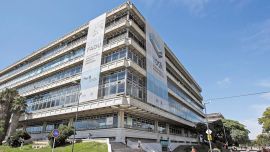Argentina exchanged a total 4.34 trillion pesos (US$21.7 billion) in a local debt swap Thursday, alleviating immediate concerns of a potential local debt default even as the government stockpiled financing problems for the next administration.
The government exchanged around 64 percent of its debt maturing through June for new notes due in 2024 and 2025, according to an Economy Ministry statement. Argentina said Monday it expected to swap 55 percent to 70 percent of its approximately US$37 billion in local obligations coming due in the second quarter.
Facing presidential elections in October, the rollover gives this Peronist government more breathing room in the coming months on its finances. But it balloons the debt burden for the next administration because many of the new notes are tied to the rate of inflation, currently barreling toward 100 percent. Higher inflation will make future payments more expensive.
The swap results also indicate low participation by private sector bondholders as half the upcoming maturities were held by public sector institutions, which were forced to rollover local debt notes anyway. Economy Ministry officials declined to provide exact figures of private sector participation.
“Figures are weaker than what we expected,” said Juan Manuel Pazos, chief economist at TPCG Valores in Buenos Aires. “Non-regulated players basically held out. The government still has a lot of work to do to clear its second-quarter maturities.”
S&P Global Ratings slashed Argentina’s local currency debt rating Thursday to selective default because it considers its peso-debt exchange “distressed based on the likelihood of conventional default,” absent the participation of creditors, S&P analysts led by Lisa Schineller wrote in a statement.
It’s the second time the credit assessor has cut Argentina’s local currency rating this year. A similar swap in January, when the nation extended maturities on 2.89 trillion pesos of notes, was also deemed a “selective default” by S&P. Soon after that, S&P raised the local currency debt rating to CCC-.
Fitch Ratings Inc declined to comment on Wednesday. A representative for Moody’s Investors Service didn’t respond to a request for comment.
Refinancing risk
Even after the exchange, Argentina has a US$174 billion mountain of local debt to manage. That pile is growing almost exponentially because so many of its obligations are linked to inflation near triple-digit territory. Economists from Argentina’s main opposition coalition have complained that the government’s debt exchange plan only delays the pain that’s coming for whoever is president after the next election.
Securities that aren’t exchanged will have to be refinanced when the country auctions new bonds, which could be expensive and difficult soon before October’s presidential election in October.
Failure to roll over its obligations risks a potential mass exodus from Argentina’s local debt in coming months, forcing the government to print money to cover its obligations and pushing inflation even higher. But President Alberto Fernández’s administration says a successful exchange will show that Argentina can keep its debt obligations under control.
“We want to leave behind the idea that Argentina is always weeks away from a default,” Economy Minister Sergio Massa said on Monday. “This will allow us to clear up any uncertainty for 2023.”
Argentina has a long history of restructuring debt, and reneging on promises to bondholders. It has defaulted on foreign bonds three times since the turn of the century, most recently in a 2020 restructuring deal that gave investors about 55 cents on the dollar. It isn’t selling foreign debt now, but the international securities it has sold previously now trade for around 30 cents on the dollar.
“With expected participation around 65 percent to 70 percent, it should be good enough for a swap, but not enough to eliminate risks,” said Alejo Costa, chief Argentina strategist at BTG Pactual in Buenos Aires. “As for a potential restructuring in the future, anyone would try to avoid it at first, but you never know.”
Some local investors like Adcap Asset Management’s Paula Gandara are sceptical the exchange will fully assuage the market’s concerns.
“But anything that aims to improve sentiment and the smooth functioning of the market is welcome,” Gandara said.
by Scott Squires & Patrick Gillespie, Bloomberg






















Comments